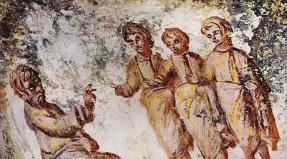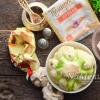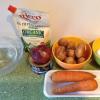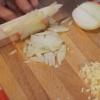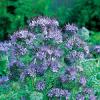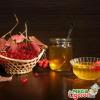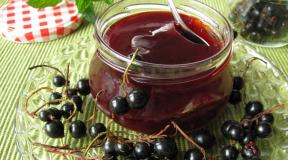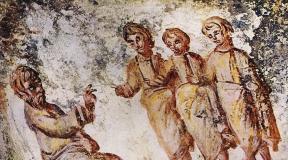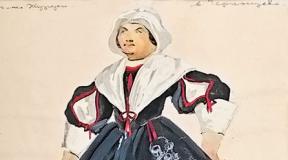Black currant Ribes nigrum L. Black currant fruits - fructus ribis nigri Black currant raw materials
Currant ( Ribes) - a genus of flowering plants of the class Dicotyledons, order Saxifragaceae, family Gooseberry.
The origin of the modern name “currant” has a couple of conflicting versions. According to one of them, the name of the bush comes from the ancient Russian word “smorod”, meaning “stench, bad smell”. According to another version, currants got their “name” from the word “to currant” - which means to emit a pleasant, strong aroma.
The mineral composition of currants is represented by the following components: sodium, calcium, magnesium, copper, sulfur, lead, silver, iron, phosphorus. Also, a high content of coumarins, pectin and iodine was found in currant fruits.
Currant berries have a number of components essential for the human body:
- malic, phosphoric and citric acids;
- essential oils;
- tannins;
- phytoncides;
- anthocyanins.
Due to its beneficial properties, currants are often used to alleviate a number of pathological conditions:
- improvement of hematopoiesis in diseases of the lymphatic and circulatory system;
- normalization of blood pressure in hypertension;
- decreased blood glucose levels in diabetes mellitus;
- restoration of immunity in case of vitamin deficiency and after serious illnesses;
- laxative, diuretic and diaphoretic effects;
- treatment of dermatitis and diathesis;
- rheumatism, gout and polyarthritis;
- gastritis and stomach ulcers;
- bleeding gums;
- increased nervous excitability and sleep disturbances.
The beneficial properties of currants also manifest themselves in decoctions and infusions: decoctions and infusions of currant berries, its leaves, buds and shoots are used to treat skin diseases. The beneficial properties of red currants are mainly concentrated in the fruits, so its juices and fresh berries are used for treatment.

Harm of currants and contraindications
Currants have a number of contraindications and can be harmful if you have the following diseases:
- increased blood clotting;
- peptic ulcer of the stomach and duodenum;
- gastritis with high acidity;
- hepatitis of any kind;
- tendency to constipation;
- there is a history of stroke;
- vein thrombosis;
- allergy to currants.
To properly plant currants you need to know:
- How to choose a place for a seedling,
- What are the timing (time) of planting currants,
- What should be the ideal soil for a plant?
- What should be the distance between currant bushes when planting?
- How to dig a planting hole,
- What fertilizers are needed?
The best place to plant currants is in open areas with maximum light throughout the day. Currants grow well on any permeable, optimally moistened soil, but they prefer chernozem loam.
Planting currant seedlings can be done in early spring, before the buds open, or in the fall, in September, the main thing is to plant the bushes in previously prepared soil. 1-2 weeks before planting, it is necessary to dig planting holes or ditches 35-40 cm deep and apply 5-6 kg of fertilizer under each currant bush: rotted manure or compost, 20-25 g of superphosphate and potassium sulfate, and then mix them well with earth.
The distance between bushes when planting currants should be at least 2-3 meters. On heavy loams, the pits are deepened to 50-60 cm and drainage is arranged at the bottom from a layer of sand, and the fertilizer rate is increased by one and a half times. On the eve of planting, the fertilized holes are spilled with water, and the currant seedlings are shortened, leaving 3-5 buds on each shoot. The seedling is planted vertically, the roots are straightened, covered with soil and watered. The settled soil is trampled down and mulched with peat or straw. It is better not to use sawdust as mulch, because it acidifies the soil and takes nitrogen from it.
For subsequent propagation, the seedling is planted obliquely, deepening the root collar by 10 cm, then additional roots and shoots will grow.

Caring for currants: pruning, fertilizing
Caring for currants does not cause much trouble. During the season, it is necessary to remove weeds and loosen the soil in the root zone. Currants need regular, but not abundant watering, otherwise the plant will immediately shed its leaves during drought.
In early spring or late autumn, blackcurrant bushes need to be rejuvenated by cutting out old branches at the root, removing diseased and low-fruiting shoots. Red currant branches are shortened by 5-6 eyes. The main thing is that no more than 10-15 shoots of different ages remain on one bush.

Fertilizing currants with fertilizers
Caring for currants involves timely feeding of bushes with fertilizers. If currants were planted in well-fertilized soil, you can do without fertilizing for the first 2-3 years. It will be enough for the bushes to incorporate mulch material into the soil in the fall, which is placed in the root zone every spring.
After 2-3 years, during the autumn digging, they begin to apply dry phosphorus-potassium mineral fertilizers at the rate of 30 g per currant bush. Urea and ammonium nitrate are washed out by melt water, so they are applied in early spring - directly on the snow or in dissolved form (20-25 g per bush). During flowering, fertilize with organic fertilizers (mullein 1:10 or bird droppings 1:15). To improve fruit set and improve the quality and size of berries, after flowering, currant bushes are sprayed with the preparation “Ovary” or a solution of zinc sulfate.
Reproduction of currants by cuttings, layering, dividing the bush
There are 3 ways to propagate currants:
- By dividing the bush,
- By cuttings,
- By layering.
Let's look at each of these methods in more detail.
The method of propagating currants by dividing the bush is not used very often. This method is excellent when there is a shortage of planting material or when very valuable varieties are forced to be transplanted from a site to another place. Another advantage of this method of transplanting currants is the rapid rooting of a new bush without any special techniques or manipulations.
The technique is quite simple: in the fall, at the end of September - beginning of October, or in early spring, the desired currant bush is carefully dug out of the ground, trying not to damage the root system. Using pruning shears or a sharp garden file, absolutely all old branches should be cut out, and young branches should be shortened to a height of 25-30 cm. Using a sharp ax, the bush should be divided into 3-4 parts (depending on its size). The main thing is that each part of the plant that you will plant in the future has well-formed buds and sufficiently branched and healthy roots. In a prepared hole, 60-80 cm deep and fertilized with rotted manure, planting material is installed in the center, covered with earth, which is carefully but tightly compacted and watered thoroughly (1-1.5 buckets for each bush).

Propagation of currants by cuttings
This method of propagating currants is considered the most productive when preserving varieties or breeding hybrids, especially when there is not very much initial planting material. Cuttings are carried out in an already prepared substrate, consisting of a mixture of soil, compost and organic fertilizer - rotted manure. Surprisingly, cuttings can be carried out both in spring and autumn (woody shoots are used for this), and in summer, using green currant cuttings. Therefore, there are no specific timings for cuttings.
- Currant cuttings in spring or autumn
One-year-old shoots are taken as lignified cuttings. You need to cut currant cuttings for propagation only from healthy bushes. It is very convenient to do this, combining it with regular pruning of the currant bush. The length of the currant cutting should be within 16-25 cm, the diameter of the cutting should be at least 6 mm. When preparing cuttings, a cut in their upper part is made directly above the bud, retreating upward 1-1.5 cm. In the lower part of the cutting, an oblique cut is made under the bud.

The cuttings are buried obliquely, leaving 2-3 buds above the soil surface. The place where the currant cuttings are planted should be watered abundantly and mulched with a layer of humus or peat. If the cuttings were planted in the spring, then by autumn quite powerful roots will form on them, and the plant can be transplanted to a permanent place. When planting currants in autumn with the onset of cold weather, the cuttings should be covered with spruce branches, fallen leaves or straw to prevent them from freezing. Please note that you need to plant currant cuttings before winter, taking into account the bush’s entry into the dormant phase. For black currants it begins in September-early October, but for red currants it begins at the end of August. It is during these months that it is necessary to start propagating currants.

- Cutting currants in summer
You need to cut green currant cuttings for propagation in the summer; it is better to do this on a cool day. Branches that are just beginning to undergo lignification are suitable for cutting: they should be quite flexible, but break if sharply bent. On a cutting 10-12 cm long, 3-5 leaf blades are left, but on a pair of lower leaves the plate is shortened by half or removed completely, leaving only the petioles. The lower ends of the prepared material are immersed in a solution of any growth substance for a day, after which green currant cuttings are planted in prepared greenhouses or greenhouses, buried 2-3 cm into the ground. The main condition for excellent survival is high humidity in the greenhouse in the first 3 weeks. Plants should be watered regularly and additionally sprayed in hot weather. In about a month, the currant cuttings will give strong roots, then they can be fed with nitrogen fertilizer and watering reduced. Next spring, young bushes are planted from the greenhouse into the soil, and by autumn they will turn into powerful currant bushes.

Botanical characteristics
Black currant is a medicinal plant that is widely used in folk and traditional medicine. Many useful products are obtained from it.
Currant (lat. Ríbes nígrum) belongs to the Currant genus and the Gooseberry family. The shrub reaches a height of two meters, has erect, branched stems, red-brown or dark-brown in color. The leaves have a characteristic pleasant aroma, petiolate. They have from three to five blades. The edges of the leaves are serrate, their apex is bare. There are golden glands on the bottom of the leaves.
When crushed, the leaves release a characteristic aroma. The arrangement of the leaves is regular. The flowers of the plant are small in size and have reddish petals. The fruits are black berries, rich in juice, with a characteristic odor. Flowering begins in the last month of spring or early summer, and fruits appear around July.
Taxonomy
Black currant belongs to the Currant genus, which includes more than 100 species. It is found in America, Eurasia, and North-West Africa.

Geography of the plant
Currants, growing in natural conditions, are found everywhere in the European part of Russia; the shrub is also found in Southern Siberia, in the east it reaches Lake Baikal. It grows in places rich in moisture: in forests, on the banks of streams and rivers. There are cases when the plant forms extensive thickets in river valleys. Currant is the mother of a large number of cultivated species. The plant is grown mainly in the north and central Russia.
Compound
- Ascorbic acid - about 400 mg. This component is important for growth and restoration of cellular balance, helps the development of tissues, blood vessels, teeth and bones. The substance helps protect the body from infections, accelerates the patient’s recovery, and stimulates the launch of immune processes. The compound is an antioxidant that accelerates the healing process of wounds and helps synthesize a number of hormones. It removes toxins and improves bile secretion.
- Sugar - up to 17%.
- Vitamin B5. Berries contain this component, which is directly responsible for immunity and resistance to allergic manifestations. This vitamin is necessary for the healthy development of hair and skin. By the way, excess vitamin is never deposited in the body, which is why overdoses do not happen.
- Other acids - 4.5%. This is a common group of compounds. Their main function is participation in the digestion process. Substances improve microflora, take part in the functioning of the gastrointestinal tract, stimulate juice secretion in the intestines, and protect the body from the development of gastrointestinal diseases. The components have anti-inflammatory, antimicrobial effects, have detoxifying properties,
- 1% proteins. These are complex organic compounds that serve as material for building cells, tissues and even organs. Substances stimulate the immune system, protect the body from infections, participate in the process of absorption of fat, vitamins, and so on.
- Pectins - up to 0.8%. It is a natural polysaccharide. The substance normalizes intestinal motility, maintains bacteriological balance in the human body, and removes toxins from the body.
- Glycosides. This is a large group of organic substances. The components transport sugar in the body, take part in redox reactions, and remove toxins from the body.
- Essential oils, etc. The substances have antiseptic, bactericidal and anti-inflammatory effects, and take an active part in the self-regulation of the body. The components have a positive effect on the scalp, nervous system and restore the beauty of the skin and hair.
Useful components are also contained in other fragments of the plant, in leaves, flowers, and buds. The leaves, for example, contain insoluble organic substances of the aromatic series, rutin, polysaccharides, ascorbic acid, mineral salts, etc. Twenty grams of currant berries can satisfy the body's daily need for vitamin C. In dry summers, the content of ascorbic acid in fruits decreases by an average of 25%. During rainy season it increases. Currants growing in the northern regions contain a lot of the above-mentioned acid.
Beneficial properties of black currant:
This wonderful plant is replete with beneficial properties. Among them are diaphoretic, diuretic, and fixative. The leaves, fruits, and buds of this shrub have found their use as a disinfectant component. This property is due to the presence of essential oil.
Herbal products prepared from the leaves help fight the dysentery bacillus. In early spring, when the body feels an urgent need for vitamins, the leaves will serve as their source. Harvested plant buds can be used in winter as vitamin supplements.

Qualities of currant leaves:
The beneficial properties of the leaves of the shrub help to obtain general strengthening and antiseptic drugs. They contain biologically active substances and vitamins.
It is often used for gout and gastritis, as well as all kinds of cardiovascular ailments. For ophthalmological diseases, traditional healers also advise consuming currants.
Currants and cooking:
Currant is a berry known to every housewife. Naturally, it has found its application in the kitchen. Delicious drinks and jam are prepared from the berries. The hostess knows a lot of recipes involving currants. Excellent fruit drinks are also obtained from it, pleasant to the taste and extremely healthy. Berries are included in cakes, casseroles, pies and other sweets.
Currants are used in a very unusual way - they make sauces for fish and meat dishes.
Use of black currant in folk medicine:
The use of currants is widespread among traditional healers, as well as in homeopathy. The berries and leaves are used in the treatment of gout, urolithiasis, gastritis, rheumatism, bronchitis, and anemia. Tinctures from berries are used to treat diseases of the genitourinary system.
The tincture of the leaves is recommended for use in the treatment of edema, colds, and scrofula. It is also recommended for rheumatism, cystitis, etc. Berry tincture can also be consumed as a drink containing beneficial vitamins.
In pediatrics, currants are used for baths in the treatment of diathesis and rickets. The syrup is used to rinse the mouth for colds.
The beneficial properties of jam made from the berries of the plant pureed with sugar are known. In winter, such a delicacy is an excellent source of vitamins. The plant also contains pectins, which remove toxins and tidy up the intestinal microflora, and also help improve digestion.
Berry decoction helps relieve constipation, stops inflammatory processes in the bladder, and helps add vitamins to your diet.
To prepare a medicinal potion, use this recipe: add up to five large spoons of frozen, dried or fresh fruits to a small saucepan. Pour boiling water into it and cook it all for several minutes. The drink must brew, this will take a couple of hours. Drink three times a day for two weeks. The norm is half a glass.
The medicinal properties of black currant make it possible to prepare a healing infusion, which is famous for its general strengthening properties. Use this recipe: chop a dozen leaves, as well as a couple of twigs of the plant. Take two large spoons of the resulting mass and pour boiling water (500 ml). The decoction should steep (about 60 minutes), after which it can be drunk half an hour before meals three times a day.
The healing potion, the recipe for which you just received, can be used for the treatment and prevention of various diseases. It also has a general strengthening effect.

Currants and cosmetology:
The amazing beneficial properties of the plant are used in cosmetology. There are many known cosmetic preparations based on this plant, which:
- nourish and moisturize the skin;
- promote epidermal regeneration;
- normalize the functioning of the sweat glands;
- help relieve irritation;
- eliminate age spots;
- promote strengthening of nails and hair;
- nourish the dermis with vitamins;
- stimulate collagen production;
- rejuvenate the skin.
The use of black currant makes it possible to obtain an extract that is the basis for the preparation of lotions and tonics, masks for the body, face and hair.
The plant is also used for making cosmetics in artisanal conditions. Masks are prepared from currants, as well as delicious lotions that have healing properties.
- Berry juice has a whitening property, so in the summer it is recommended to wipe the skin with a cotton swab dipped in the juice.
- The juice is frozen in the refrigerator, after which it is used for an invigorating massage.
- The juice of unripe berries helps whiten the skin. The product is mixed with table vinegar and stirred until it becomes milky in color. You can wipe your face with the finished herbal product twice a day.
Plant research
To date, the medicinal properties of black currant have not been fully studied. The study of this plant is a promising direction of science. Preparations containing currant extract are being studied. They help treat high eye pressure.
In Japan, the effect of plant anthocyanins on the vision of people with glaucoma was studied. The experiment was carried out over two years. Patients received mainly drops. Useful components were taken in a dosage of 50 milligrams once a day for two years. Those receiving the beneficial components had improved vision and ocular blood flow. The authors of the experiment recognized black currant as an excellent additional component to the main therapy for people suffering from glaucoma.
In Japan, the effect of blackcurrant components on visual impairment during prolonged contact with a computer monitor was also studied. When using currant extract in three different dosages, a decrease in the dark adaptation threshold was found, in other words, the subjects began to see much better in the dark. The experiment leads to the conclusion that people who consume the berries of the plant and are forced to spend a lot of time working with a computer will retain their vision.
New Zealand conducted its own research on blackcurrant juice. The results showed that the product was able to relieve pain during exercise. 10 athletes took part in the experiment; they were of different ages. People trained for three weeks and took currant extract before and after training. One pill was equivalent to 28 grams of berries. The experiment showed that over time, the athletes showed significantly less muscle damage and signs of oxidation. Scientists believe that this is all due to the presence of flavonoids in the composition.
In Siberia, scientists studied the chemical composition of blackcurrant berries during its processing and how technology affects the final indicators.
Currently, an urgent task for some institutes is the development of rational processing of fruit and berry raw materials with minimal costs.
Blackcurrant is famous for its unique composition, but during processing a lot of active substances are lost, which is why scientists are trying to find different processing methods in order to preserve the beneficial substances as much as possible.
Scientists came to the conclusion during the study that the berries contain water-soluble and alcohol-soluble compounds that have antioxidant activity, therefore, in the process of processing berries, it is always necessary to take into account the characteristics of the chemical composition and use the right type of solvent.
Scientists have found that during the conservation process, the chemical composition of the plant changes, the number of dry soluble substances increases, and this has a positive effect on diffusion when obtaining extracts.
It has been established that the solvent affects the efficiency of extracting biologically active substances, so general recommendations have also been developed on the technology for obtaining natural dyes from the plant.
Contraindications
The use of currants is prohibited for persons suffering from thrombophlebitis. If the acidity of the stomach is high, it is also not recommended to consume products based on this plant.
In Europe, plant bushes grew in the northern regions as far as Kamchatka. The use of currants as a medicinal product was known back in the fifteenth century. In the eighteenth century, currants gained recognition among the British, French and Germans.
Currant is a relative of Gooseberry. The plant is found on all continents of the planet, except Antarctica and Australia. There are already approximately 150 species of this plant.
By the way, the name of the plant was given by the Arabs. They consumed a lot of rhubarb, which they called "ribas". In 711, Spain was conquered by the Arabs, and they were horrified that the country did not have their favorite rhubarb, and without it the food did not seem so tasty. It was then that they paid attention to currants, which had a pleasant sourish taste, reminiscent of rhubarb, and began to call the plant also “ribas”.
In Russia, epics mention a river named after the plant - “Smorodinovka”. Some historians say that it is the “Moscow River”, because it was on its banks that currants grew, which were actively used for food.
Previously, the plant was called the monastery berry, since in almost all monasteries the monks grew currants. The chronicles of Novgorod and Pskov even speak about this.
Many people think that unripe currants are a completely unhealthy product, but in reality everything is different. Unripe berries contain 4 times more vitamins, which protect the human body from illnesses and strengthen the immune system.
Not only the berries of currants are useful, but also the leaves. In Ancient Rus', people even prepared dried leaves. The leaves contain a lot of vitamins that are useful for the development of the body. In winter, the body lacks vitamins, which is why people in Ancient Rus' dried leaves to compensate for the lack of nutrients.
Currants are an unusually useful product that cures many ailments. You can order currant extracts right now. Don't put it off until later.
see alsoName: Black currant
 Latin name: Ribes nigrum L.
Latin name: Ribes nigrum L.
Family: Saxifragaceae (Saxifragaceae)
Kinds: Currently, more than 100 cultivated varieties of black currant have been bred, the ancestor of which is a wild plant.
Plant type: Small, 0.6-1.3 m tall shrub with a characteristic odor.
Leaves: Petiolate, alternate, 3-5 lobed, serrate along the edge, glabrous above, with yellowish glands below.
Flowers, inflorescences: Flowers are bisexual, regular, bell-shaped, lilac or pinkish-gray, in drooping racemes of 5-10 flowers.
Flowering time: May June.
Ripening time: July.
Collection time: Buds are collected in winter and early spring, leaves - in summer (June-July), berries - during full ripeness.
Features of collection, drying and storage: Leaves and buds are dried at a temperature of 35-40°C, fruits are consumed fresh or dried (starting from 35°C and gradually increasing to 65°C, avoiding drying out). Yield of dry raw materials: buds 20%, leaves – 16%, berries – 14%.
Spreading: In Russia, under natural conditions, black currant is found in the European, including the Arctic, parts (Karelo-Murmansk, Dvina-Pechora, Ladoga-Ilmensky, Upper Volga, Volga-Kama, Volga-Don and Zavolzhsky regions), in Western and Eastern ( Yeniseichsky, Leno-Kolyma and Angara-Sayan regions) of Siberia; in Ukraine - in the Carpathians and Carpathian region, in Polesie and in the Forest-steppe.
Habitats: Grows singly and in small thickets near rivers and streams, in forests, among bushes (in damp places).
Medicinal parts: Leaves, less often – buds and berries.
Useful content: The leaves contain tannins, essential oil, flavonoids, phytosterol, pentosans, organic acids, mineral salts, vitamin C and emulsin enzyme. The chemical composition of the buds is close to the composition of the leaves. The berries contain up to 16% invert sugars and sucrose, fatty oil, anthocyanin pigments cyanidin and delphinidin, about 4% organic acids (tartaric, citric, malic), pectins, emulsin, vitamins C, K, P, carotene, group vitamins and mineral salts (boron, iodine).
Actions: All types of raw materials have diuretic, diaphoretic, astringent and tonic properties. They are used as an adjuvant in the treatment of rheumatism, gout, arthritis, gastritis, vascular sclerosis, urolithiasis, diarrhea, migraines, colds, whooping cough, sore throat and tonsillitis. The plant is used primarily in teas.
Fresh or dried berries are useful to use for hypochromic anemia, periodontal disease, diseases of the gastrointestinal tract, glomerulonephritis, cardiac arrhythmias, cardiac neuroses, hemorrhagic vasculitis, colds and infectious diseases.
Medicinal recipes:
Red currants, or Common currant, or Garden currant- monoecious shrub up to 1-1.8 m tall. The branches are light gray, young ones are light yellow, light brown, often covered with stalk-like glands. Leaves with 3.5 wide-triangular, short-pointed or almost obtuse lobes (the upper 3 lobes are almost the same size), (3-8) x (4-10) cm, with a heart-shaped or cut base, unequally obtuse-toothed, almost glabrous above, bare or bare below fluffy, rarely glandular-hairy. Flowers 4-20 in racemes 2-7(10) cm long. The flowers are bisexual, bell-shaped to saucer-shaped, 3-8 mm in diameter and 3-5 mm long. Sepals are yellowish and greenish to purple. The berries are red, very rarely white, spherical or oval, 7-11 mm in diameter, glabrous, sour, edible.
It grows naturally in clumps in river floodplains, less commonly found under forest canopy (where it often does not bloom) over a large area of Siberia, the Russian Far East, Mongolia and China.
It grows well on sufficiently moist, average fertility soils, but also tolerates poor soils. Drought-resistant, shade-tolerant, gas-resistant. Growth is fast. It blooms from mid-May and bears fruit in August.
Propagated by seeds and summer cuttings; woody cuttings take root more difficult. When sowing in spring, preliminary cold stratification of seeds is required for 3-4 months.
Decorative foliage and, especially, during fruiting. Recommended for use in landscaping singly and in groups as undergrowth, it is well trimmed. It is of great interest as a valuable berry crop, long and widely known throughout almost the entire territory of Russia. Numerous varieties have been created based on the species.
White currant 10
White currant(lat. Ribes niveum) - deciduous shrub of the family Gooseberry(Grossulariaceae).
The habitat of white currant is in the forest zone throughout Eurasia, where it grows wild. Found on forest edges, prefers the banks of rivers or streams.
14
 , or Golden currant- deciduous shrub 1-2(3.5) m tall. The leaves are simple, 3-5-lobed, glabrous above, bright green, sparsely hairy below. The flowers are golden yellow, large, in racemes, fragrant. The berries are brown-red, yellow or black, edible.
, or Golden currant- deciduous shrub 1-2(3.5) m tall. The leaves are simple, 3-5-lobed, glabrous above, bright green, sparsely hairy below. The flowers are golden yellow, large, in racemes, fragrant. The berries are brown-red, yellow or black, edible.
Homeland - North America. In the south of Russia and Central Asia the plant has a colloquial name " crandal"(by the name of one of the varieties cultivated in the territory of the former USSR). In nature, the species' range covers the southwestern regions of Canada, the central and western regions of the United States, and northern Mexico. The plant has been naturalized and cultivated in Europe, Central Asia and throughout North America. On the territory of Russia it is found in the European part, the Caucasus, Altai Territory and the Far East.
In Novosibirsk (TsSBS): shrub at 12 years old, 1.8 m tall. Fruits well from 4 years old, regularly. In severe winters, the ends of annual shoots freeze. It is drought-resistant, undemanding to soil conditions, grows well on clay and even saline, as well as dry sandy soils. Tolerates slight shade and trims well.
Propagated by seeds, layering, cuttings. It is better to sow freshly harvested seeds in the fall. When sowing in spring, cold stratification is necessary for at least 3 months.
It is especially decorative during the periods of flowering, fruiting and autumn, when the leaves turn orange and red. In landscaping it can be used in groups, hedges, edges and as undergrowth in sparse plantings. Recommended for field protective plantings. The berries are edible and can be cultivated as a berry crop, especially in arid areas where black currants grow only if watered.
Flaw: leaves are sometimes affected by fungal diseases and insect pests.
The plant is drought-resistant (unlike other types of currants)
 - monoecious deciduous shrub up to 2-3 m tall. The branches are dark brown, purple, with peeling or peeling bark. The leaves are 3-5-lobed, dense, dark green above, shiny, whitish below. The flowers are bisexual, yellow-brown, inconspicuous, in racemes up to 8 cm long. The fruits are black, about 7 mm in diameter, sour, edible.
- monoecious deciduous shrub up to 2-3 m tall. The branches are dark brown, purple, with peeling or peeling bark. The leaves are 3-5-lobed, dense, dark green above, shiny, whitish below. The flowers are bisexual, yellow-brown, inconspicuous, in racemes up to 8 cm long. The fruits are black, about 7 mm in diameter, sour, edible.
It grows sporadically on stone placers and rocks, mainly in the upper part of the mountain forest belt of Siberia and Mongolia.
In Novosibirsk (CSBS): at 10-12 years old, 0.4-0.5 m tall. It is undemanding to soils, but does not tolerate stagnant moisture. Drought-resistant, light-loving. Winter-hardy.
Propagated by seeds, layering, stem and summer cuttings, dividing bushes. When sowing in spring, seeds must be stratified for at least 3 months at a temperature of 2-5 °C.
Recommended for single and group plantings and for alpine slides. It has original stems covered with lead-gray shiny bark. The bush is sparsely leafy and hung with clusters of shiny black-purple berries. Decorative both during flowering with an abundance of narrow pale purple flower clusters, and during fruiting.
Propagated by seeds and summer cuttings.
Flaw: leaves are often damaged by fungal diseases and insect pests.
 - dioecious shrub 1-3 m tall. The bark of the branches is gray, sometimes with a brown or purple tint. Young shoots are yellow, light brown. At the base of the leaf petioles there are usually paired spines; barren shoots are more prickly, with thorns located at the internodes. Very rarely the plant is not thorny. The leaves are collected in bunches, round, obovate, 1.5-3.0 cm in diameter, with 3-lobed, mostly obtuse, jagged apices, hard, often shiny and dark green above, lighter below. Female flowers 3-24 pcs. in brushes 1-4 cm long, male ones - shorter (up to 2 cm). The sepals and petals are bare, white, yellowish, greenish on the outside. The berries are orange, red, spherical, diameter 5-9 mm, smooth, inedible.
- dioecious shrub 1-3 m tall. The bark of the branches is gray, sometimes with a brown or purple tint. Young shoots are yellow, light brown. At the base of the leaf petioles there are usually paired spines; barren shoots are more prickly, with thorns located at the internodes. Very rarely the plant is not thorny. The leaves are collected in bunches, round, obovate, 1.5-3.0 cm in diameter, with 3-lobed, mostly obtuse, jagged apices, hard, often shiny and dark green above, lighter below. Female flowers 3-24 pcs. in brushes 1-4 cm long, male ones - shorter (up to 2 cm). The sepals and petals are bare, white, yellowish, greenish on the outside. The berries are orange, red, spherical, diameter 5-9 mm, smooth, inedible.
It grows singly or in small groups on rocks, rocky mountain slopes, in the valleys of steppe rivers, and on the edges of steppe forests.
Natural range: Transbaikalia, southern Primorye, China, Korea.
In Novosibirsk (CSBS): shrub at 11-15 years old, 1.5-1.8 m tall. Blooms in June, bears fruit in July-August, regularly.
Winter hardiness 1-2. It is content with relatively infertile soils. Drought-resistant, light-loving, fast growth. After 15 years, rejuvenation is necessary.
Propagated by seeds, summer cuttings and division of the bush. Seeds for spring sowing require preliminary cold stratification for 3-4 months.
Recommended for additional use in landscaping in single and group plantings, on alpine hills and slopes. Good haircut. Decorative with shiny leaves, especially during the fruiting period.
 , or Aldan grapes- monoecious deciduous shrub up to 1.5 (2) m tall. The branches are ash or dark gray. Young shoots are light brown, with sparse dotted glands and white hairs. Leaves are simple, with 3.5 sharp lobes, (5-13) x (4-10) cm. Flowers are 7-20 in racemes 6-8 cm long, bisexual, bell-shaped or flat, 5-9 mm in diameter and up to 9 mm long. The sepals are white, the petals are white or yellowish. The berries are blue-black, with a bluish waxy coating, spherical or slightly oblong, diameter 8-20 mm, glabrous, odorless, edible.
, or Aldan grapes- monoecious deciduous shrub up to 1.5 (2) m tall. The branches are ash or dark gray. Young shoots are light brown, with sparse dotted glands and white hairs. Leaves are simple, with 3.5 sharp lobes, (5-13) x (4-10) cm. Flowers are 7-20 in racemes 6-8 cm long, bisexual, bell-shaped or flat, 5-9 mm in diameter and up to 9 mm long. The sepals are white, the petals are white or yellowish. The berries are blue-black, with a bluish waxy coating, spherical or slightly oblong, diameter 8-20 mm, glabrous, odorless, edible.
It grows in small clumps in the floodplains of large rivers within the forest belt, less often along small rivers in Eastern Siberia and in the Russian Far East.
In Novosibirsk (CSBS): the shrub is 0.9 m high at 5 years old, 1.5-1.8 m high at 10-15 years old. It blooms at the end of May, bears fruit at the end of July. Winter hardiness 1. Prefers fairly fertile and well-moistened places. Not drought-resistant, shade-tolerant.
Propagated by seeds, layering and summer cuttings, lignified cuttings take root worse. When sowing in spring, seeds must be pre-stratified for 3-4 months at a temperature of 3-5 °C.
Recommended for use in protective afforestation and green construction in single and group plantings. Decorative during flowering and abundant fruiting. Valuable species for breeding.
Flaws: leaves are often affected by fungal diseases, less often by insect pests, and sometimes suffer from drought.
 - dioecious deciduous shrub up to 2.5 m tall. The bark of the branches is gray, bare, flaky. Young shoots are reddish. The leaves are simple, 3-lobed, coarsely toothed, often shiny on top, 2-6 cm in diameter. The berries are red, mostly spherical, 6-12 mm in diameter, glabrous, sweet, inedible.
- dioecious deciduous shrub up to 2.5 m tall. The bark of the branches is gray, bare, flaky. Young shoots are reddish. The leaves are simple, 3-lobed, coarsely toothed, often shiny on top, 2-6 cm in diameter. The berries are red, mostly spherical, 6-12 mm in diameter, glabrous, sweet, inedible.
Naturally grows singly in bush thickets on open rocky slopes, in light deciduous forests, mainly near rocks in the southern regions of the Primorsky Territory, in China, Korea. In Novosibirsk (CSBS): the shrub is 1.1-1.6 m tall at 10 years old, 1.7-2.2 m tall at 25 years old. It blooms in late May-early June. It bears fruit from the age of 4, in the second half of July-early August, regularly, well. Winter hardiness 1-2. For normal growth, fertile alkaline, sufficiently moist soils are required. Shade-tolerant.
Propagated by seeds and summer cuttings. When sowing in spring, preliminary cold stratification of seeds is required for 3-4 months. After 15-20 years, rejuvenation is necessary.
Recommended for additional use. Decorative with a thick rounded crown and shiny (often) foliage, especially during the period of fruiting and the autumn coloring of the leaves in yellow and pink tones. Recommended for single and group plantings and for creating alpine slides.
 - monoecious deciduous shrub 0.7-1.7 m tall. Young shoots are often pale brown. The leaves are simple, 3-5-lobed, serrated, thin. Flowers 4-15 pcs. in dense clusters 2-5 cm long. The flowers are bisexual, bell-shaped, 4-5 mm long. Sepals and petals are dirty purple or light with purple veins. The berries are red, dark red, spherical, diameter 5-10 mm, glabrous, sour, edible.
- monoecious deciduous shrub 0.7-1.7 m tall. Young shoots are often pale brown. The leaves are simple, 3-5-lobed, serrated, thin. Flowers 4-15 pcs. in dense clusters 2-5 cm long. The flowers are bisexual, bell-shaped, 4-5 mm long. Sepals and petals are dirty purple or light with purple veins. The berries are red, dark red, spherical, diameter 5-10 mm, glabrous, sour, edible.
It grows in the mountain forest belt under the forest canopy, in floodplains of rivers and streams in Siberia, Central Asia, Northern Mongolia in areas with a climate similar to that of Novosibirsk or colder.
In CSBS: shrub 1-2 m tall. Blooms for 8-13 days in late May-early June. It bears fruit from the age of 4 in mid-August, regularly. Winter hardiness 1. Grows well in fertile, sufficiently moist places, not drought-resistant, medium shade-tolerant.
Propagated by seeds and summer cuttings; woody cuttings take root more difficult. Seeds for spring sowing must be stratified for 3 months at a temperature of 2-5 °C.
Recommended for widespread use in landscaping and protective afforestation as single or group plantings, when creating alpine slides. Particularly decorative during flowering and fruiting periods.
Black currant
Ribes nigrum
Family - Gooseberries - Grossulariaceae.
Common names: alpine berry, gout berry.
Parts used: ripe fruits and leaves, buds.
Pharmacy name - black currant fruits - Ribis nigri fructus (formerly Fractus Ribis nigri), black currant leaves - Ribis nigri folium (formerly Folia Ribis nigri).
 Botanical description
Botanical description
Black currant - The plant is 1-2m in height, young shoots are fluffy, pale, and mature shoots are brown. 3-5 lobed leaves 3-12 cm long and wide, with jagged edges, bearing oil glands on the underside.
Inflorescences are drooping racemes 3-8cm long, 5-10-flowered, with bare or fluffy pedicels 3-8mm long.
7-9mm long, 4-6mm in diameter, located in pendulous racemes, yellowish-green, brownish-red at the edges. From them, first brown-black, later black fruits develop.
Petals are oval. Sepals are bent outward, pointed, rather wide. The fruit is an edible fragrant berry, with an average diameter of 1 cm, black-brown or greenish, with a glossy skin and 3-37 seeds.
Black currant blooms from April to May. Grows along coastal thickets, in damp deciduous, mixed and coniferous forests and on their outskirts, in alder forests, along the banks of rivers, lakes, along the edges of swamps and in wet floodplain meadows, singly and in small thickets.
Black currant grows almost throughout Europe, Kazakhstan, China and northern Mongolia. Widely cultivated.
Collection and preparation
Black currant leaves are harvested from the beginning of flowering until leaf fall. The middle ones are collected, leaving the top and bottom ones, so as not to interfere with fruiting next year, drying is done in air.
The buds are removed at the end of winter, in February-March, and preserved with vodka.
The fruits are collected as they ripen. First, they are dried and then dried in dryers at a temperature of 35-40°C or in attics. But more often the berries are processed into juice, which is poured into bottles without additives and sterilized. It can also be used to make a well-preserving jelly with sugar.
Active ingredients
Essential oil, vitamin C, B, P, organic acids, pectins, tannins and minerals.
 Healing effect and application
Healing effect and application
Black currant has strengthening, anti-inflammatory, tonic, antiallergic, antitussive, antidiabetic, as well as antiemetic, diuretic and diaphoretic, disinfectant and antimicrobial, antifungal and antirheumatic, choleretic and hormonal effects.
Black currant has the ability to prevent cancer and protect against diseases of the cardiovascular system. Black currant also prevents the weakening of mental abilities in older people. Blackcurrant surpassed all berries in terms of the amount of vitamins, minerals and other beneficial substances it contains. It also increases the body's resistance to various diseases. As a source of vitamins, black currants can be consumed in any form. It is important to note that the beneficial properties of black currant berries are preserved in homemade preparations during processing and canning.
The fruits are given for coughing and hoarseness, as a prophylactic against colds and, above all, as a remedy for acute and chronic diarrhea, which is characterized by extremely unpleasant symptoms. The fruits of black currant are also used for hypo- and avitaminosis, anemia, as a general tonic for severe chronic diseases, and also as a therapeutic and prophylactic agent for hypertension and atherosclerosis.
Berries and leaves are used to treat gums. Fresh and dried berries should be consumed in any quantity when tumors appear. Dried black currant fruits are sometimes used for diseases of the urinary system, to remove heavy metals from the body. The fruits and leaves have a tonic, diuretic, astringent, anti-inflammatory and diaphoretic effect. As a vitamin remedy, it is used for hypo- and avitaminosis, asthenia, anemia, to improve appetite, as well as in the presence of problems of the gastrointestinal tract, dysbacteriosis, vomiting, constipation, hemorrhoids, diseases of the urinary system, the appearance of edema, urinary retention, rheumatism, chronic skin diseases, gout, tuberculosis, inflammation of the lymph glands, diseases of the stomach, intestines, liver and kidneys.
 Decoctions of black currant berries help with anemia, hypertension, bleeding gums, stomach and duodenal ulcers, and gastritis.
Decoctions of black currant berries help with anemia, hypertension, bleeding gums, stomach and duodenal ulcers, and gastritis.
Black currant buds and leaves are used as a diuretic and disinfectant for urolithiasis, pyelonephritis and rheumatism and gout. Treatment with infusion of leaves is recommended in courses. Infusions of leaves and buds have a diaphoretic effect and are also effective for whooping cough and diseases of the upper respiratory tract.
An infusion of leaves is indicated for stomatitis as a mouth rinse, high blood pressure and atherosclerosis. A decoction of the leaves helps with tuberculosis of the lymph nodes. Currants are included in preparations for the treatment of allergies, oncology, for the removal of uric acid salts, cholesterol, and as an antipyretic.
A decoction of branches, buds and leaves in the form of baths and lotions is recommended for dermatitis and exudative diathesis.
It is used in the treatment of stomach and duodenal ulcers, gastritis with low acidity, and mixed with honey it is used successfully to treat coughs and severe headaches. Berry juice, diluted with water, is used for rinsing for hoarseness, sore throats and inflammatory diseases of the oral cavity.
Tea from leafy twigs is taken for severe headaches, urolithiasis, and urinary retention.
A bath made from a mixture of twigs and leaves of currant and juniper perfectly tones and contributes to the overall strengthening of the body. Baths from a decoction of currant leaves are used for various rashes and skin diseases.

